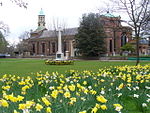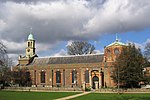Kew College
1927 establishments in EnglandKew, LondonPreparatory schools in LondonPrivate co-educational schools in LondonPrivate schools in the London Borough of Richmond upon Thames ... and 1 more
Use British English from September 2019
Kew College Prep is a non-denominational mixed preparatory school in Kew in the London Borough of Richmond upon Thames. Despite its name, Kew College Prep is a primary school for children aged 3 to 11.
Excerpt from the Wikipedia article Kew College (License: CC BY-SA 3.0, Authors).Kew College
Cumberland Road, London Kew (London Borough of Richmond upon Thames)
Geographical coordinates (GPS) Address Phone number Website External links Nearby Places Show on map
Geographical coordinates (GPS)
| Latitude | Longitude |
|---|---|
| N 51.48067 ° | E -0.2847 ° |
Address
Kew College Prep
Cumberland Road 24
TW9 3HQ London, Kew (London Borough of Richmond upon Thames)
England, United Kingdom
Open on Google Maps









